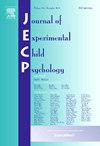运动想象与 7 至 14 岁儿童体能的发展轨迹:为期一年的跟踪研究。
IF 1.8
2区 心理学
Q3 PSYCHOLOGY, DEVELOPMENTAL
引用次数: 0
摘要
运动想象(MI)与运动系统有着根本性的联系。它能提高运动学习能力,优化运动动作,而无需身体执行,这突出了它在康复计划和运动表现中的独特作用。了解运动想象(MI)的发展轨迹以及影响其在不同年龄段变化的因素,可以为儿科康复提供更有效的、针对特定年龄段的策略。本研究在相隔一年的两个时间点对 65 名 7 至 14 岁的儿童进行了评估。通过儿童运动想象力问卷对其运动能力进行了评估,并通过SLOfit测试对其体能进行了评估。在所评估的三种视角(内部视觉意象(IVI)、外部视觉意象(EVI)和动觉意象(KI))中,KI 的独特之处在于在两个时间点均与年龄无关。多元智能视角的发展在运动员和非运动员之间存在差异,与运动员相比,非运动员的 IVI 有所下降。在第二次评估中,各组之间的 KI 存在显著差异,而在第一次评估中也观察到了类似的趋势,这进一步证明了这种差异。在体能测试中,只有 600 米跑与两次评估中的 KI 一致。我们的研究结果表明,经常参加体育运动对 KI 的表现有很大影响,这突出了参加体育运动对儿童多元智能能力发展的重要性。未来的研究应针对不同年龄组和运动经历的其他评估点进行检查,以更好地了解多元智能的发展及其对儿科康复的潜在影响。本文章由计算机程序翻译,如有差异,请以英文原文为准。
Developmental trajectories of motor imagery in relation to physical fitness in children aged 7 to 14 years: A 1-year follow-up study
Motor imagery (MI) is fundamentally linked to the motor system. It improves motor learning and optimizes motor actions without physical execution, highlighting its unique role in rehabilitation programs and motor performance. Understanding the developmental trajectories of MI and the factors influencing its variability across ages could enable more effective, age-specific strategies for pediatric rehabilitation. This study assessed 65 children aged 7 to 14 years at two time points 1 year apart. MI ability was assessed using the Movement Imagery Questionnaire for Children, and physical fitness was evaluated using the SLOfit testing battery. Among the three perspectives assessed; internal visual imagery (IVI), external visual imagery (EVI), and kinesthetic imagery (KI), KI was unique in not correlating with age at both time points. The development of MI perspectives varied between athletes and non-athletes, with non-athletes showing a decline in IVI compared with athletes. This differential was further evidenced by significant differences in KI between the groups at the second assessment, with a similar trend observed at the first assessment. Of the physical fitness tests, only the 600-m run correlated consistently with KI at both assessments. Our findings suggest that regular participation in sports significantly affects KI performance, highlighting the importance of sports participation for the development of MI abilities in children. Future research should examine additional assessment points in different age groups and sport experience to better understand the development of MI and its potential implications for pediatric rehabilitation.
求助全文
通过发布文献求助,成功后即可免费获取论文全文。
去求助
来源期刊

Journal of Experimental Child Psychology
Multiple-
CiteScore
4.50
自引率
7.70%
发文量
190
期刊介绍:
The Journal of Experimental Child Psychology is an excellent source of information concerning all aspects of the development of children. It includes empirical psychological research on cognitive, social/emotional, and physical development. In addition, the journal periodically publishes Special Topic issues.
 求助内容:
求助内容: 应助结果提醒方式:
应助结果提醒方式:


